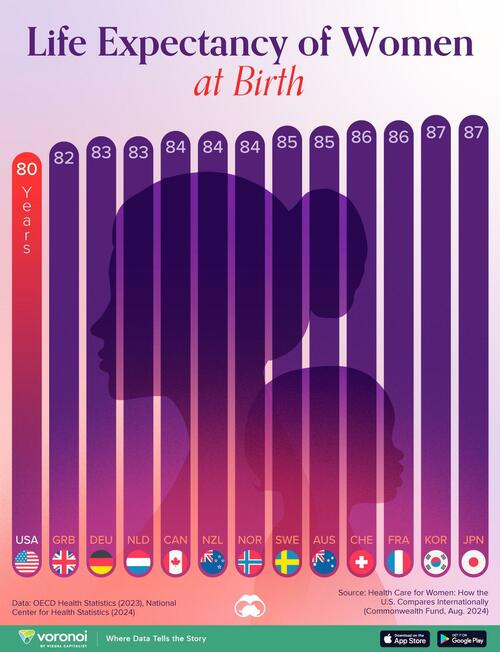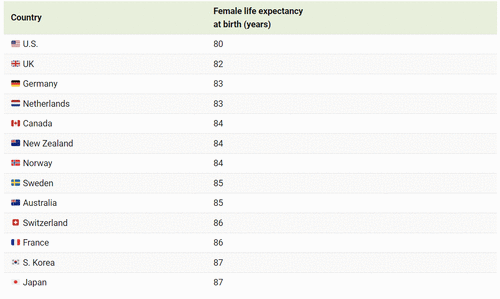
In this graphic, Visual Capitalist's Marcus Lu shows female life expectancy at birth across a selection of high-income countries, based on data compiled by The Commonwealth Fund.
It highlights how women’s life expectancy in the U.S. is at least two years lower than its peers, despite the country spending more on health care...
Data and Key Takeaways
The figures we used to create this graphic are listed in the table below. Data availability for life expectancy at birth varied and is as follows: 2020 (UK), 2021 (CAN, KOR, NZ), 2022 (AUS, GER, JPN, NOR), 2023 (FRA, NETH, SWE, SWIZ).
Life expectancy can be attributed to a number of factors including living standards, lifestyle choices, quality of education, and access to health services.
Based on other data collected by The Commonwealth Fund, access and affordability appears to be a leading problem in the United States.
For example, among high-income countries, American women are the most likely to struggle with paying their medical bills, and are also the most likely to skip needed care due to costs.
America’s outlier status on this measure likely stems from the large number of working-age women who lack health insurance - nearly 10 million - as well as the high copayments, coinsurance, and deductibles that many U.S. women enrolled in commercial health plans face when seeking care.
Further data from The Commonwealth Fund shows that 14% of American women do not have health insurance, rising to 26% among Hispanics.
To see more data on this topic, check out our visual comparison of life expectancy vs. health spending across developed nations.
In this graphic, Visual Capitalist’s Marcus Lu shows female life expectancy at birth across a selection of high-income countries, based on data compiled by The Commonwealth Fund.
It highlights how women’s life expectancy in the U.S. is at least two years lower than its peers, despite the country spending more on health care…
Data and Key Takeaways
The figures we used to create this graphic are listed in the table below. Data availability for life expectancy at birth varied and is as follows: 2020 (UK), 2021 (CAN, KOR, NZ), 2022 (AUS, GER, JPN, NOR), 2023 (FRA, NETH, SWE, SWIZ).
Life expectancy can be attributed to a number of factors including living standards, lifestyle choices, quality of education, and access to health services.
Based on other data collected by The Commonwealth Fund, access and affordability appears to be a leading problem in the United States.
For example, among high-income countries, American women are the most likely to struggle with paying their medical bills, and are also the most likely to skip needed care due to costs.
America’s outlier status on this measure likely stems from the large number of working-age women who lack health insurance – nearly 10 million – as well as the high copayments, coinsurance, and deductibles that many U.S. women enrolled in commercial health plans face when seeking care.
Further data from The Commonwealth Fund shows that 14% of American women do not have health insurance, rising to 26% among Hispanics.
To see more data on this topic, check out our visual comparison of life expectancy vs. health spending across developed nations.
Loading…






